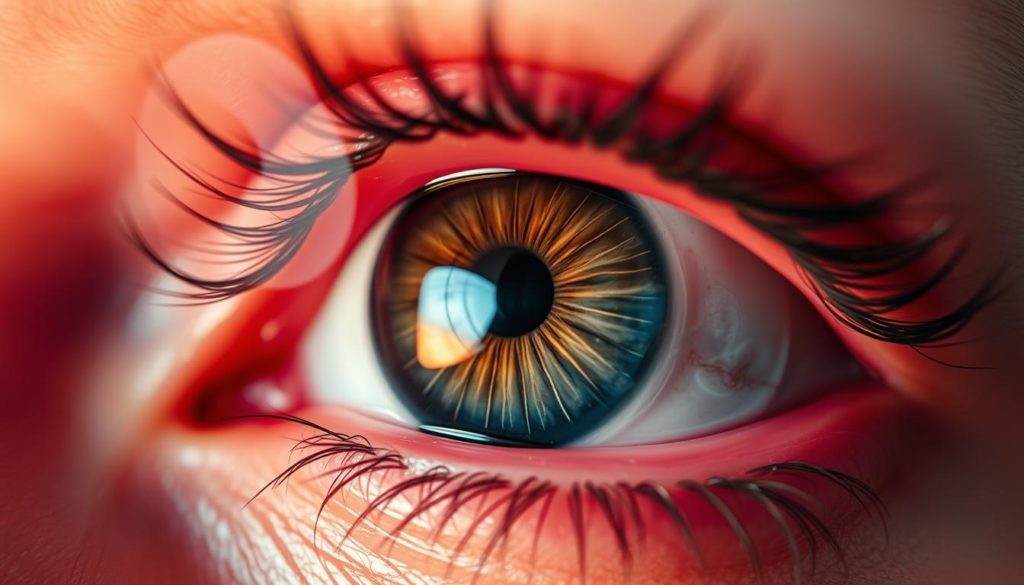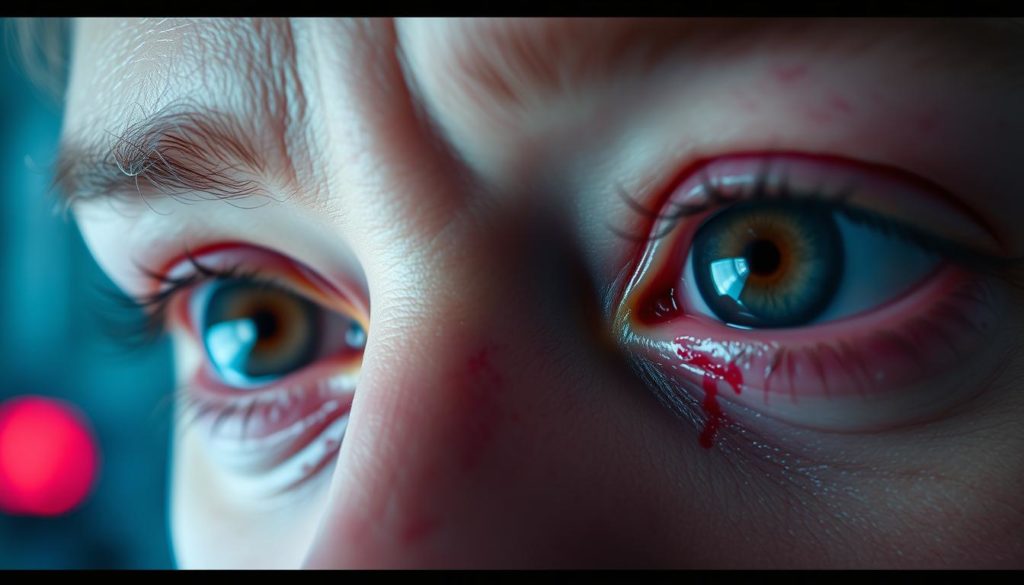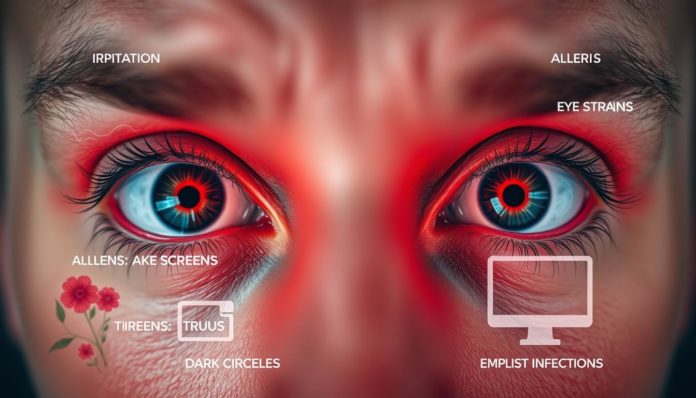About 40 million Americans get red eyes every year. This problem can look like bloodshot eyes. It can be caused by many things. Some of these causes are not serious, but others can be. These include allergies, dry eyes, and serious infections. It’s important to know why it happens to get better.
Red eyes happen when blood vessels on the eye surface swell. This makes the eye look red. There are many reasons for red eyes. These include harmless things like dry eyes or sun. But, it can also be something serious like glaucoma or infections. It’s good to know what causes red eyes.
Red eyes are usually not as serious as pain or changes in vision. But, you should know when to see a doctor. Problems like scratches on the cornea, bleeding under the conjunctiva, or uveitis need a doctor’s help.
If red eyes last more than a few days or if there is pain, problems seeing, or sensitivity to light, you should see a doctor. Knowing what causes red eyes can help you take care of your eyes.
What Are Red Eyes?
Red eyes, or bloodshot eyes, happen when the vessels in your eye’s white part swell. You can see this swelling, making the eye look red.

Knowing why red eyes occur helps in finding the cause. This issue may come with itchiness, some discharge, or pain. These are signs you might need to see a doctor.
Definition of Red Eyes
Red eyes mean the white area of your eye turns red. This happens when blood vessels widen or break. Doctors call this scleral or conjunctival injection. This is why your eyes appear red.
Common Symptoms
People with red eyes often feel different symptoms. Some are mild, but others might be severe. These symptoms include:
- Itchiness
- Watery or mucous discharge
- Pain or discomfort around the eyes
- Blurred vision in severe cases
Knowing these symptoms helps catch problems early. This leads to better care for your eyes.
Eye Infections Leading to Red Eyes
Infections play a big role in causing eye redness. Knowing the different types can help pinpoint the cause and seek the right treatment.
Blepharitis
Blepharitis causes eyelid inflammation, leading to red, itchy eyes. Symptoms include swelling, itching, and a sandy feeling in the eyes. It’s usually long-term, needing regular cleaning and sometimes medicated treatments.
Conjunctivitis
Conjunctivitis, or pink eye, inflames the eyelid’s lining. It’s a common cause of red eyes, with symptoms like redness, itching, and discharge. It can be caused by viruses or bacteria and is very contagious.
Corneal Ulcers
Corneal ulcers are sores on the cornea, often from serious infections. They cause severe discomfort, blurry vision, and light sensitivity. Seeing a doctor right away is crucial to avoid lasting damage.
Uveitis
Uveitis is uvea inflammation, related to autoimmune diseases, infections, or toxins. It causes red eyes, pain, blurry vision, and sensitivity to light. Quick treatment is necessary to avoid further issues.

Quickly addressing these infections can stop long-term eye problems. It shows why knowing symptoms and getting a doctor’s help is crucial.
Allergies and Red Eyes
Allergies are a top factors causing red eyes. These reactions can ruin a bright-eyed morning, making eyes itchy and watery.
Hay Fever
Hay fever, or allergic rhinitis, is common and often causes red eyes. It’s set off by allergens like pollen, grass, and weeds. When exposed, people’s eyes get red and itchy.
Common Allergens
Many factors cause red eyes through allergies. Commonly, these include:
- Pollen
- Dust mites
- Pet dander
- Mold spores
- Certain medications
These allergens quickly lead to red, irritated eyes, a familiar issue for allergy sufferers.
Allergic Reactions
Allergic reactions are the body fighting off what it sees as harmful. With eyes, this means redness, itching, and watering. Allergies making eyes red can really affect daily activities.
Dealing with red eyes means knowing the factors causing them, like allergens. Managing the condition involves allergy tests and treatments like antihistamines.
Dry Eyes and Redness
Having dry eyes and redness can make everyday tasks hard. We’ll look at the causes, symptoms, and ways to deal with this issue.
Causes of Dry Eyes
Dry eyes happen mainly when you don’t make enough tears or they’re of poor quality. Things like wind, smoke, and low humidity play a role too. So do staring at screens, some medicines, and getting older.
Symptoms of Dry Eyes
Feeling like there’s sand in your eyes, a burning sensation, blurred sight, and light sensitivity are common signs. Your eyes may also turn red and feel more irritated after long periods of reading or screen use.
Treatments for Dry Eyes
There are many treatments, from simple store-bought eye drops to prescriptions. Making changes in your daily habits helps too, like cutting down on screen time, using humidifiers, and wearing sunglasses. For serious cases, doctors may suggest specific therapies to tackle dry eyes at the root, improving your eye comfort and health.
Injury and Trauma Causing Red Eyes
Various injuries and trauma can make our eyes turn red, which is worrying. Knowing what causes red eyes and how to give immediate help can ease the pain. It also stops more serious problems.
Physical Injury
Hitting your eye, getting something in it, or burns can cause red eyes. Such injuries break blood vessels, making the eye look red.
Chemical Exposure
Chemicals are also a big reason for red eyes. They can scratch the eye’s surface or really irritate it. This causes red-eye symptoms. It’s important to be careful with chemicals to avoid getting them in your eyes.
First Aid Tips
Immediate first aid is crucial for treating red eyes from injuries. Here’s what you should do:
- Rinse the affected eye with saline or clean water.
- Avoid rubbing or pressing the eye.
- Seek medical assistance promptly for severe injuries.
By following these first aid steps, you can lessen the impact of red eyes from injuries. It helps speed up the healing process.
Common Causes of Red Eyes
It’s key to know why red eyes happen to find the right fixes. Many things cause this condition, from your surroundings to health issues.
Introduction to Common Causes
There are two big groups of causes for red eyes: things around us and health problems. Understanding them helps come up with ways to deal with it.
Environmental Factors
Red eyes can come from the environment around us:
- Pollutants in the air
- Exposure to smoke
- Chlorine in swimming pools
These things can make your eyes red and uncomfortable. It’s how your eyes react to these irritants.
Medical Conditions
Health issues can also make your eyes red:
- Ectropion
- Entropion
- Various forms of conjunctivitis
To tackle these causes, you need the right medical care. This way, you can keep symptoms under control and avoid more issues.
Contact Lens Complications
Wearing contact lenses can lead to some eye problems. This includes red eyes, discomfort, and infections. We will look into these problems and how to prevent them.
Types of Complications
Common complications from contact lens use are:
- Corneal Ulcers: These open sores on the cornea are mostly caused by bacteria.
- Infections: Bad lens hygiene can cause fungal or bacterial infections, leading to red eyes.
- Dry Eyes: Lenses may cut down tear production, which causes dryness and irritation.
- Allergic Reactions: Some people might react badly to the lens solutions or the lenses.
Preventative Measures
To cut down on contact lens issues, try these steps:
- Maintain Good Hygiene: Always clean your hands before touching lenses. Keep your lens case clean and get a new one every three months.
- Follow Recommended Wear and Care Instructions: Stick to the wearing schedule your eye doctor suggests. Don’t wear lenses too long.
- Use Proper Cleaning Solutions: Only use the cleaning solutions recommended for your lenses. Never use water or saliva on them.
- Regular Eye Check-ups: Go for eye exams regularly to keep your eyes in good health and catch any issues early.
By taking these steps, you can keep your eyes healthy. You’ll avoid problems that come with wearing contact lenses.
Eye Strain and Digital Devices
In our world today, we use screens a lot. This can cause eye strain and red eyes. When we stare at screens for too long, our eyes can get tired and show signs of strain.
Digital Eye Strain
Digital eye strain, also called computer vision syndrome, comes from too much screen time without breaks. It leads to headaches, blurry vision, and discomfort. Knowing the eye strain reasons helps us deal with it better.
Preventing Eye Strain
To avoid digital eye strain and red eye triggers, some habits can really help. Using the 20-20-20 rule, managing the lighting, and taking breaks are key steps. You can also adjust your screen brightness and its position to ease the strain.
- Implement the 20-20-20 rule
- Optimize lighting conditions
- Take regular screen breaks
- Adjust screen brightness and position
Glaucoma and Red Eyes
Glaucoma is a serious eye condition that increases pressure inside the eye. This pressure can harm the optic nerve, leading to blindness. Red eye is one sign of glaucoma.
Types of Glaucoma
Glaucoma comes in types like open-angle and angle-closure glaucoma. Open-angle glaucoma is the more common form. Angle-closure glaucoma is also called acute glaucoma. It causes severe symptoms and needs quick medical care.
Symptoms of Acute Glaucoma
Acute glaucoma shows symptoms such as severe eye pain, headaches, feeling sick, throwing up, sudden vision loss, and red eyes. It’s key to know these signs for early treatment.
Emergency Treatment
If red eyes and other signs of acute glaucoma show up, get medical help right away. This is an emergency. Fast action can save your sight. Regular eye checks are vital, especially for those at greater risk. To learn more about glaucoma’s connection to red eyes, check out this resource.
Subconjunctival Hemorrhage
A subconjunctival hemorrhage happens when a blood vessel on the eye’s surface breaks. This causes a clear red patch to form. Often, this condition doesn’t hurt, and many might not see it until looking in a mirror.
It can occur from simple things like coughing, sneezing, or straining too hard. Understanding why red eyes happen can clear up a lot of questions about this condition.
Causes and Symptoms
Intense activities that raise blood pressure can cause a subconjunctival hemorrhage. This includes tough exercise, severe coughing, or lifting heavy things. An injury to the eye might also lead to a hemorrhage.
The main symptom is a visible red patch on the eye’s white part. This redness does not hurt vision. Also, there’s no discharge or serious discomfort.
When to Seek Medical Help
Usually, a subconjunctival hemorrhage is not a big deal and gets better by itself in two weeks. But, there are times when you should see a doctor. If the redness stays for more than two weeks, comes back often, or if there’s pain, vision changes, or bleeding in other eye areas, get medical help.
In some scenarios, these signs could mean something more serious. So, it’s wise not to overlook them.
FAQ
What are the common causes of red eyes?
Many things can make your eyes red. These include dry eyes, too much sun, dust, and allergies. Infections, getting hurt, and problems from wearing contact lenses can also cause redness. So can looking at screens too much or certain health issues like glaucoma.
What are red eyes, and what are their symptoms?
When the small blood vessels in your eyes get swollen, we call it red eyes. This can make your eyes itchy, leaky, or hurt. If it gets really bad, it might even affect how well you can see.
How do eye infections lead to red eyes?
Infections like blepharitis and pink eye make your eyes red. They can itch, leak crud, hurt, and make light bother you. If you have these signs, you need to see a doctor fast.
How do allergies cause red eyes?
Allergies from things like pollen and pet hair can make your eyes red. You’ll feel itchy and watery. There are special treatments to help ease these problems.
What are the causes and symptoms of dry eyes?
Not having enough tears leads to dry eyes. This can make your eyes red, feel sandy, burn, and mess with your sight. There are drops and other treatments to help fix this.
How do injuries and trauma cause red eyes?
Getting hit or having something burn or hurt your eyes can turn them red. Right away, washing your eye with saline can help stop more harm or an infection.
What are environmental factors that contribute to red eyes?
Things like air pollution, smoke, pool chlorine, and the weather can irritate your eyes. This irritation can make your eyes become red.
How do contact lenses cause red eyes?
Wearing contact lenses wrong can lead to red eyes because of ulcers, infections, or not using them right. Keep your lenses clean, follow the instructions, and get your eyes checked often to avoid problems.
How does digital eye strain contribute to red eyes?
Staring at screens too long can strain your eyes, making them red. It can also cause discomfort, headaches, and blurry vision. Try the 20-20-20 rule, check your lighting, and take breaks to prevent strain.
How are glaucoma and red eyes related?
Glaucoma, especially the acute kind, can make your eyes red. It comes with bad headaches, vision problems, feeling sick, and throwing up. It’s urgent to get medical help if you have these signs.
What causes a subconjunctival hemorrhage, and when should you seek medical help?
This happens when a blood vessel pops on your eye’s surface, usually from straining. It looks like a bright red spot. While it’s not usually serious, you should talk to a doctor if it doesn’t get better or if there are other symptoms.


